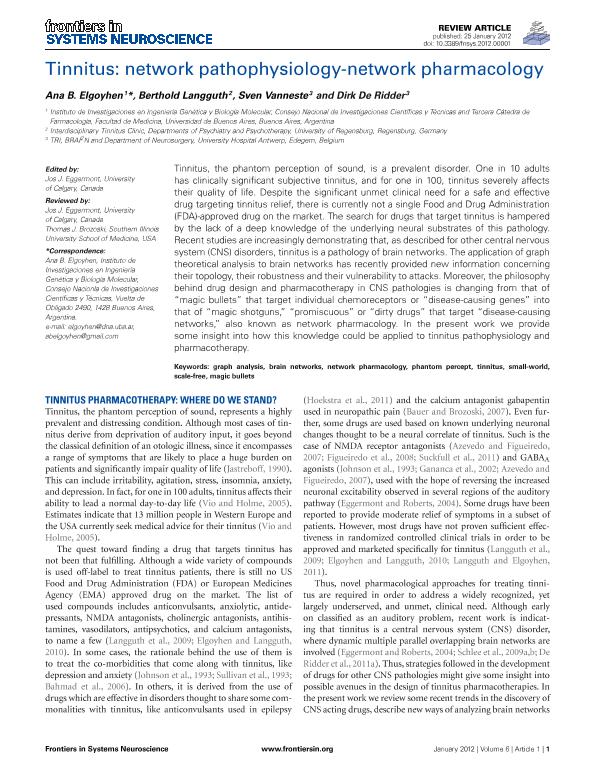Mostrar el registro sencillo del ítem
dc.contributor.author
Elgoyhen, Ana Belen

dc.contributor.author
Langguth, Berthold
dc.contributor.author
Vanneste, Sven
dc.contributor.author
de Ridder, Dirk
dc.date.available
2019-07-11T19:57:18Z
dc.date.issued
2012-01
dc.identifier.citation
Elgoyhen, Ana Belen; Langguth, Berthold; Vanneste, Sven; de Ridder, Dirk; Tinnitus: Network path physiology-network pharmacology; Frontiers; Frontiers in Systems Neuroscience; Jan; 1-2012; 1-12
dc.identifier.issn
1662-5137
dc.identifier.uri
http://hdl.handle.net/11336/79404
dc.description.abstract
Tinnitus, the phantom perception of sound, is a prevalent disorder. One in 10 adults has clinically significant subjective tinnitus, and for 1 in 100, tinnitus severely affects their quality of life. Despite the significant unmet clinical need for a safe and effective drug targeting tinnitus relief, there is currently not a single FDA-approved drug on the market. The search for drugs that target tinnitus is hampered by the lack of a deep knowledge of the underlying neural substrates of this pathology. Recent studies are increasingly demonstrating that, as described for other central nervous system disorders, tinnitus is a pathology of brain networks. The application of graph theoretical analysis to brain networks has recently provided new information concerning their topology, their robustness and their vulnerability to attacks. Moreover, the philosophy behind drug design and pharmacotherapy in central nervous system pathologies is changing from that of "magic bullets" that target individual chemoreceptors or "disease-causing genes" into that of "magic shotguns", "promiscuous" or "dirty drugs" that target "disease-causing networks", also known as network pharmacology. In the present work we provide some insight into how this knowledge could be applied to tinnitus pathophysiology and pharmacotherapy.
dc.format
application/pdf
dc.language.iso
eng
dc.publisher
Frontiers
dc.rights
info:eu-repo/semantics/openAccess
dc.rights.uri
https://creativecommons.org/licenses/by-nc-sa/2.5/ar/
dc.subject
Brain Networks
dc.subject
Graph Analysis
dc.subject
Magic Bullets
dc.subject
Network Pharmacology
dc.subject
Phantom Percept
dc.subject
Scale-Free
dc.subject
Small-World
dc.subject
Tinnitus
dc.subject.classification
Neurociencias

dc.subject.classification
Medicina Básica

dc.subject.classification
CIENCIAS MÉDICAS Y DE LA SALUD

dc.title
Tinnitus: Network path physiology-network pharmacology
dc.type
info:eu-repo/semantics/article
dc.type
info:ar-repo/semantics/artículo
dc.type
info:eu-repo/semantics/publishedVersion
dc.date.updated
2019-07-10T13:41:05Z
dc.journal.number
Jan
dc.journal.pagination
1-12
dc.journal.pais
Suiza

dc.journal.ciudad
Lausanne
dc.description.fil
Fil: Elgoyhen, Ana Belen. Consejo Nacional de Investigaciones Científicas y Técnicas. Instituto de Investigaciones en Ingeniería Genética y Biología Molecular "Dr. Héctor N. Torres"; Argentina. Universidad de Buenos Aires. Facultad de Medicina; Argentina
dc.description.fil
Fil: Langguth, Berthold. Universitat Regensburg; Alemania
dc.description.fil
Fil: Vanneste, Sven. University Hospital Antwerp; Bélgica
dc.description.fil
Fil: de Ridder, Dirk. University Hospital Antwerp; Bélgica
dc.journal.title
Frontiers in Systems Neuroscience
dc.relation.alternativeid
info:eu-repo/semantics/altIdentifier/doi/http://dx.doi.org/10.3389/fnsys.2012.00001
dc.relation.alternativeid
info:eu-repo/semantics/altIdentifier/url/https://www.frontiersin.org/articles/10.3389/fnsys.2012.00001
Archivos asociados
